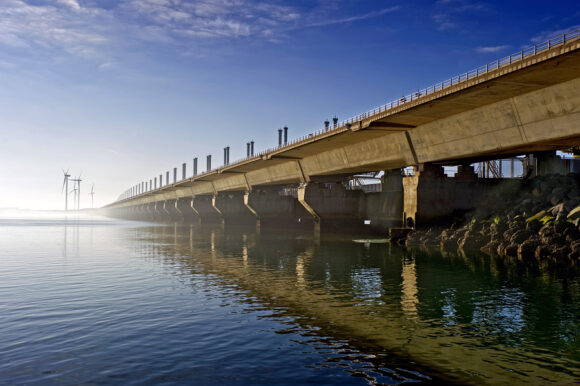As Jersey shore towns spend millions to rebuild boardwalks wrecked by Superstorm Sandy, some are opting for an additional layer of protection in the form of steel sea walls placed between the boards and the shoreline.
The idea is to protect the boardwalks – and the homes and businesses nearby – from the destructive power of storm surges in the next big one.
“It has to be an engineered sea wall and dune system that will protect the boardwalk and mitigate against the storm surge going into the neighborhood,” said Belmar Mayor Matthew Doherty. His town was the first to begin rebuilding its boardwalk after Sandy, and was the first to decide it wanted to protect that new boardwalk with a sea wall. “This way, instead of washing away the boardwalk, the storm surge will be stopped by the sea wall.”
But not everyone is convinced the costly add-ons will work. Some environmentalists and scientists say the hard barriers actually worsen erosion as waves scour sand at the base of the walls.
Jeff Tittel, director of the New Jersey Sierra Club, likened sea walls to the Maginot Line, a line of fortifications the French erected after World War I, believing it would deter Germany from attacking.
“The Germans just went around it, which is what the storm surge will do to sea walls,” he said. “They just don’t work; you’re going against the forces of nature. It’s a false sense of security.”
He and other environmentalists say sea walls actually speed up erosion and sand loss because the energy of the waves smacks up against the steel, and is channeled upward and downward, washing away sand at the base of the wall.
Jon Miller, a professor of coastal engineering at New Jersey’s Stevens Institute of technology, said sea walls can help protect boardwalks – but only when they themselves are protected by a constantly nourished and replenished beach between the walls and the surf.
“If it’s done correctly, it can be part of the solution,” he said. “The key is to maintain the beach in front of it. Otherwise it just becomes a vertical wall and just accelerates erosion.”
A case in point has been the severe erosion that has plagued beaches in Sea Bright and Monmouth Beach. Most of those two towns are protected by a giant rock-and-concrete sea wall.
But the wall has functioned exactly as Miller described, forcing the pounding of the waves downward and washing away most of the sand in front of it., Consequently, those two communities are among the most needy at the Jersey shore in terms of requiring constant beach replenishment projects.
A Duke University study of shoreline protection in the Carolinas and New Jersey reached the same conclusion: that sea walls accelerate erosion, even as they protect property.
“Unquestionably, many buildings along many miles of long-stabilized U.S. shorelines owe their existence to the presence of sea walls,” the study read. “The fact that beaches along these same stretches of stabilized shoreline are frequently narrow and even absent altogether has captured the attention of coastal managers everywhere. Two states, North Carolina and Maine, anxious to avoid ‘New Jersey-ization’ of their own shores, prohibit altogether hard stabilization.”
Supporters say the sea walls being contemplated in the wake of Sandy are much more modest, and would be covered with sand and dune grass that should, in theory, withstand at least the initial stages of a storm surge.
Miller said it “does make some sense” to locate a small sea wall east of the boardwalk as an added protection measure for the walkway, as long as there is an adequate beach between the wall and the surf.
Given the expense involved in rebuilding boardwalks, some communities are willing to consider sea walls. Seaside Heights is spending $3.6 million on the first phase of its boardwalk reconstruction, and Belmar is spending $6.6 million. Spring Lake is in the process of rebuilding its 2-mile-long boardwalk for the second time in little over a year. Tropical Storm Irene destroyed it in 2011, the town rebuilt it, and Sandy wrecked it again in 2012.
“We’re looking at what we can do to make it safer going forward,” said Spring Lake Mayor Jennifer Naughton. Her town is considering various options, including a sea wall, but has yet to decide on any of them. A sea wall in Spring Lake could cost as much as $18 million, she estimated. Belmar’s lowest bid on a sea wall came in at $4.5 million.
“We need to figure out how to finance that,” Doherty said.
That poses another problem: The Federal Emergency Management Agency generally will only pay to restore public property to its pre-storm state. Protective measures beyond what was in place when Sandy hit would need new funding, such as hazard mitigation grants.
Was this article valuable?
Here are more articles you may enjoy.


 Tricolor Trustee Plans to Sue Founder for Auto Dealer’s Collapse
Tricolor Trustee Plans to Sue Founder for Auto Dealer’s Collapse  Atmospheric River to Flood Pacific Northwest Through Week
Atmospheric River to Flood Pacific Northwest Through Week  NYT Asks Judge to Dismiss Trump’s ‘Implausible’ Defamation Suit
NYT Asks Judge to Dismiss Trump’s ‘Implausible’ Defamation Suit  OpenAI And Microsoft Sued Over Murder-Suicide Blamed on ChatGPT
OpenAI And Microsoft Sued Over Murder-Suicide Blamed on ChatGPT 